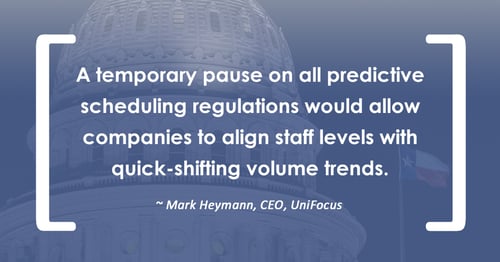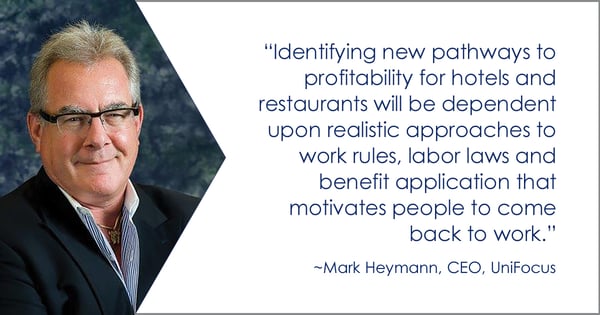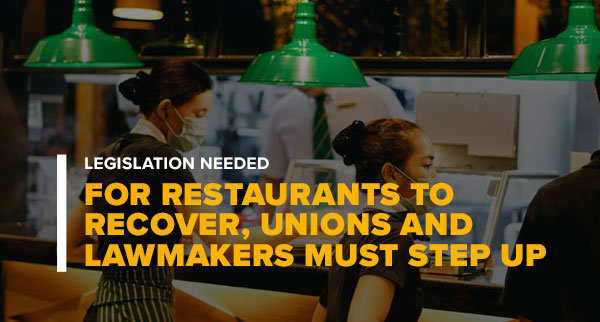July 2020 - Published in FSR Magazine - By Mark Heymann, CEO, UniFocus - “We cannot choose our external circumstances, but we can choose how we respond to them.”
Although I wish I could say I crafted that quote myself, it actually comes from a first-century Greek philosopher named Epictetus. Given the current situation, we should all take a page out of his book. If we’ve learned anything over the past few months, it’s that the societal effects of the novel coronavirus pandemic have drastically altered the way hotels and restaurants must operate moving forward. Changes will need to be made that address the circumstances of a new reality for the service industry. Our response will dictate our ability to recover.
First is the complex challenge of bringing guests and patrons back amid ongoing concerns about traveling and gathering in public settings, which will require ramped up sanitation guidelines, strict occupancy limits, social distancing practices and several other new measures. But on the other hand, limited childcare services, unemployment benefits may well prohibit or deter a significant portion of hotel and restaurant employees from returning to work. The restaurant industry alone employs 3.5 million parents. Approximately 1 million of them are single mothers, many of whom have at least one child under the age of 13. While these people can’t afford to remain unemployed in the long term, they also can’t afford to leave their children at home unattended.
From a labor law and work rules perspective, now is the time for policy changes that ease restrictions on hotels and restaurants to give them the means to recover more quickly. To address these issues, our government officials, primarily local, on both sides of the aisle should start shifting their focus toward enacting swift bipartisan legislation that provides support for two sectors (restaurant and hospitality) that produce a combined $1 trillion in average annual profits each year. Like desperate times call for desperate measures, an unprecedented recovery calls for unprecedented changes.
 In reality, our current labor policies are not optimized for a post-pandemic recovery. During times like these, hotels and restaurants shouldn’t be subjected to predictive scheduling laws that impose unnecessary fines for essential shift changes amid these extreme periods of uncertainty. For example, employers in Seattle and San Francisco are required to post employee work schedules 14 days in advance, while in New York City, employers are prohibited from on-call scheduling within 72 hours of a shift. Any changes after the designated cutoff times result in monetary penalties—such as accounting for hours of expected pay—that are given to the affected employee. Other major cities like Chicago and Philadelphia impose similar predictive scheduling regulations, like requiring employers to provide new hires with honest “good faith” estimates of how many hours they can work per week, as well as expected shift times, dates and durations.
In reality, our current labor policies are not optimized for a post-pandemic recovery. During times like these, hotels and restaurants shouldn’t be subjected to predictive scheduling laws that impose unnecessary fines for essential shift changes amid these extreme periods of uncertainty. For example, employers in Seattle and San Francisco are required to post employee work schedules 14 days in advance, while in New York City, employers are prohibited from on-call scheduling within 72 hours of a shift. Any changes after the designated cutoff times result in monetary penalties—such as accounting for hours of expected pay—that are given to the affected employee. Other major cities like Chicago and Philadelphia impose similar predictive scheduling regulations, like requiring employers to provide new hires with honest “good faith” estimates of how many hours they can work per week, as well as expected shift times, dates and durations.
These laws were created during clearly different times, under the assumption that hotels and restaurants could accurately predict their scheduling needs, driven by a forecast process that had far lower levels of uncertainty than we see today. Obviously, the landscape has changed due to COVID-19, and an oncoming new normal of unstable, ever-changing guest volumes will make it nearly impossible during this recovery period to forecast staffing needs at the accuracy that would make predictive scheduling laws fair and reasonable. In that sense, hotels and restaurants shouldn’t be penalized for the ebbs and flows of the recovery process, especially when budgets are extremely tight and capacities are limited. Legislation for a temporary pause on all predictive scheduling regulations would allow companies to align staff levels with quick-shifting volume trends, in turn improving their operational efficiency and reducing unnecessary staffing related costs to help pave the road to recovery.
And it wouldn’t just benefit the business side of things. From the employee perspective, scheduling flexibility may well be required as availability can change at the last-minute due to partner schedules, childcare accessibility, or other non-foreseeable issues. Availability could need to be adjustable on a week to week basis to fit around new pandemic-related obligations outside of work, while the times and durations of specific shifts can be tailored to work-life balance, peak service periods or staff shortages.
At the same time, state laws that require employers to pay their employees overtime wages after eight hours must be put on hiatus. With the challenges of outside care issues and transportation costs, extended work hours on a particular day can provide multiple benefits. If able, employees can work three 12-hour shifts or four 10-hour shifts in a week to reduce at least one or two days of childcare concerns. It decreases the cost of work while also reducing the number of different people one comes in contact with during the workday.
Theoretically, imagine a restaurant is open from 11:30 AM to 10 PM—totaling 10 and half hours. It needs six people per-hour to operate which converts to 63 hours of labor. Using 8-hour shifts and minimum 4-hour shifts, the number of employees needed will average out to 12 for the entire day. Going to a 12-hour shift model means you only need six employees for this particular day, which means you just cut interactions by 50 percent on a staff-to-staff basis. This isn’t an attempt to suggest that overtime rules don’t have their place, but in today’s unique circumstances, waiving them for a period while holding to the 40 hour per week overtime requirement may be quite helpful to both the employer and employee.
 On a broader spectrum, state and federal policymakers should take a hard look at streamlining the unemployment benefit structure. Like the labor policies noted above, our federal unemployment program simply isn’t optimized for COVID-19 recovery—especially after 20.5 million people lost their jobs over a 30-day span. As it stands today, those who receive unemployment are unable to hold part-time roles. Once an individual returns to work in any capacity, they stop receiving benefits—resembling an all-or-nothing model that disincentivizes the value of returning to work.
On a broader spectrum, state and federal policymakers should take a hard look at streamlining the unemployment benefit structure. Like the labor policies noted above, our federal unemployment program simply isn’t optimized for COVID-19 recovery—especially after 20.5 million people lost their jobs over a 30-day span. As it stands today, those who receive unemployment are unable to hold part-time roles. Once an individual returns to work in any capacity, they stop receiving benefits—resembling an all-or-nothing model that disincentivizes the value of returning to work.
For example, let’s say a line cook named Jerry was laid off from an Italian restaurant when the pandemic first started. Now, it’s July, and since he was a great employee, the restaurant wants to rehire him for its grand reopening. Except this time around, it can only afford to give him 25 hours per-week, which nets $800 on his bi-weekly paycheck. On the contrary, his state’s unemployment benefits pay $700 every two weeks, along with a weekly $600 federal stipend from the CARES Act to combine for a bi-weekly total of $1,900. Now depending on where he lives, his unemployment will be adjusted in one of many ways to account for the working income he has received. And, it is Jerry who must report it.
In response, state and federal policymakers should push for significantly simplified calculations of unemployment benefits that encourage employees to rejoin the workforce. Employers would report an individual’s weekly hours and pay to the state’s unemployment operations, who would in turn determine the reduced rate of benefits based on that pay. If an employee was paid for 20 hours one week, then they’d be entitled to partial unemployment equivalent to 50 percent of their typical disbursement. If they worked 28 hours the following week, the rate would be flexed again to coincide with the new hourly total. Overall, a simplified flexing unemployment program would serve as a win-win, with the employer and employee both receiving ongoing support until their respective situations fully improve. It further increases the period that employees have benefits while not increasing the cost to the system. This also assists employees on getting back on firmer footing in their lives. Complex calculations for the average employee will lead to status quo or staying on unemployment, unless they can easily see how going back to work, even part-time, will make them better off financially.
Another area to consider is workforce optimization. Can changes be made that help hotels and restaurants maintain profitability amidst reduced volumes? It will require new sets of innovative practices that allow businesses to do what’s necessary with less cost. Loosened restrictions on cross-utilization and minimum shift requirements will be paramount during the early stages of recovery, which is where contract negotiations with labor unions come into the equation. If unions will agree to temporarily relieve certain cross-utilization limits, hotels and restaurants will have a much easier time keeping labor costs down without sacrificing workplace performance. These types of adjustments can be put in place with parameters that relate to restoring historical volume levels. A determination, as part of these negotiations, can be made that declares if the combined business volume over a four-week span measures to 75 percent of the same period last year, then full contract terms are put back in place. This data is easily verifiable and helps ensure that more stable recoveries occur.
As an example, UniFocus conducted a study analyzing the impact of minimum shift requirements on labor costs. When we changed the requirement from 4 hours to 2 hours in a database encompassing 5,000 employees, the employee cost was improved by 17 percent. That just goes to show how minor changes, like decreasing 4-hour mid-day shifts to two, can produce major results. This does not necessarily mean that an employee would only work two hours per day. What it shows is that with increased cross-utilization and a task-based staffing structure, employees can fulfill multiple jobs on the same shift, some of which only need two hours of attention. It’s just a change in orientation based on some degree of relief under present contract terms.
In unprecedented times, we need unprecedented action. During the recovery process, identifying new pathways to profitability for hotels and restaurants will be dependent upon more realistic approaches to work rules, labor laws and benefit application that motivates people to come back to work. The faster hotels and restaurants work their way up the profit curve, the faster unemployment will drop. It will require all related partners having an openness to change. It’s time to get on the same side of the table.







